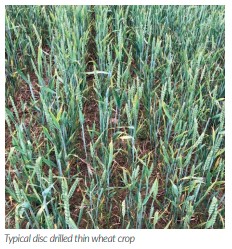With three trade shows coming in quick succession this year, LAMMA, Cereals and Groundswell, the question of
which colour you like your steel painted comes into focus once again.
Written by James Warne from Soil First Farming
Along with the rise of the Conservation Agriculture techniques being adopted on more and more farms across the UK, the choice of zero-till drills seems to grow day-by-day. Significant government support incentives also has an involvement in driving this growth, but without the most sensible outcomes. Machinery manufacturers are showing their ability to design ever more sophisticated machines, mostly based around a disc style opener. Machines are becoming every larger and heavier and demand a greater draft requirement. Very few tine opener machines are available and are clearly not in favour, which needs to be addressed in our opinion.
As usual at this time of year, with wheat now full in ear across the country, the variation in crop establishment can now be seen. Consistent with the last few years a lot of thin zero-tilled crops are evident. The push for later and later drilling exacerbating this effect. This is the disc drill fallacy.

With many soils in the UK now very low in organic matter it has lost the glue which binds it together. Low organic matter soil has generally has poor structure, and tends to slump and compact easily. Without the glue and the structure soil no longer has the porosity for air and water to move freely within it. In our maritime climate there are times when our soils have to cope with prolonged periods of excess water. A lot of focus is put into sorting out failing drainage systems. While this is important, if the soil porosity is not connected to the drains its largely irrelevant.
Too often we see soils which have slumped due to low organic matter, and excess water, being late drilled with a disc drill. More often than not these crops tend to come through the winter low in plant numbers and are unable to tiller adequately to compensate, resulting in thin crops now being visible. Narrow knife style tine openers tend to operate better in the early years of zero-till on low OM soils. Tines will create a little tilth to improve seed to soil contact, whereas discs do not create any tilth. When the soil is moist a disc will actually smear the seed slot it creates further reducing drainage and restricting crop rooting. Seed slots created by disc drills in wet conditions may appear closed at the time of drilling but will open again as the soil dries in the spring exposing the root crown to the air.
With second cereals disc drills can also be problematic when drilling into chopped straw. Do not underestimate the effects of hair-pinning on the subsequent crop. Thin or small-eared second cereals seen now could be a result of the actions taken at drilling. It may not be the fault of a firm soil or lack of moisture or nutrition, it may simple by the wrong choice of drill for the situation.
Overcoming chemical imbalances within the soil can also help alleviate the effects of a soil with poor structure. The water retaining properties of magnesium are well understood.
Magnesium can hold onto 18 molecules of water when fully hydrated. Magnesium also has a relatively large charge density compared to other common soil elements like calcium so water has a greater attraction to magnesium. This tends to keep soils wetter and then dry rapidly, giving greater shrinkage when it finally dries. This shows when the slots open as the soil surface dries as mentioned above. It can also help with structure and porosity improving water movement and infiltration. Understanding how the magnesium and calcium balance is affecting your soil can lead to better decision making around drilling and crop establishment.

In our opinion a tine drill is critical for success in the early years of zerotill. Simple, uncomplicated, low draft requirement tine drills can have a very big impact on the success of zero-till adoption in the UK. The choice of disc versus tine drill at the point of drilling is a critical control point many growers are overlooking. Simple tine drills give great opportunities and low draft requirements even with large output potential.